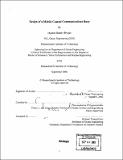Design of a mobile coastal communications buoy
Author(s)
Hendry-Brogan, Meghan
DownloadFull printable version (15.60Mb)
Other Contributors
Massachusetts Institute of Technology. Dept. of Ocean Engineering.
Advisor
Chryssostomos Chryssostomidis.
Terms of use
Metadata
Show full item recordAbstract
In response to a growing interest in networked communications at sea as well as the needs of our vital commercial fishing industry, the Northeast Consortium funded a novel research initiative to establish wireless acoustic and radio communications at sea. The platform used for this type of telemetry instrumentation was to be a buoy which could not only withstand the often harsh conditions off the northeastern coast of America (specifically, Cape Ann), but do so while exhibiting an exceptionally small response in heave and roll. A spar type buoy was designed and built at the MIT Sea Grant facility. Spars are a special type of buoy shape whose hydrostatic and hydrodynamic interactions with the sea are decoupled enough so that extreme sea conditions do not induce extreme buoy motions. Most oceanographic buoys are of the discus type, and move as the surface of the ocean does. This type of wave-following buoy would not sufficiently facilitate the requirements of the high-bandwidth wireless networking hardware, and therefore would not serve the current purpose. (cont.) The NEC buoy displaces approximately 140 kg of sea water and is roughly 11 feet long when fully assembled, not including its 5 foot antenna mast. The buoy employs a PC104 stack to control an 802.1 lb wireless card and antenna, an acoustic modem card and transducer, other peripheral instrumentation, a main battery, and a solar power system.
Description
Thesis (S.M.)--Massachusetts Institute of Technology, Dept. of Ocean Engineering, 2004. Includes bibliographical references (leaves 71-72).
Date issued
2004Department
Massachusetts Institute of Technology. Department of Ocean EngineeringPublisher
Massachusetts Institute of Technology
Keywords
Ocean Engineering.